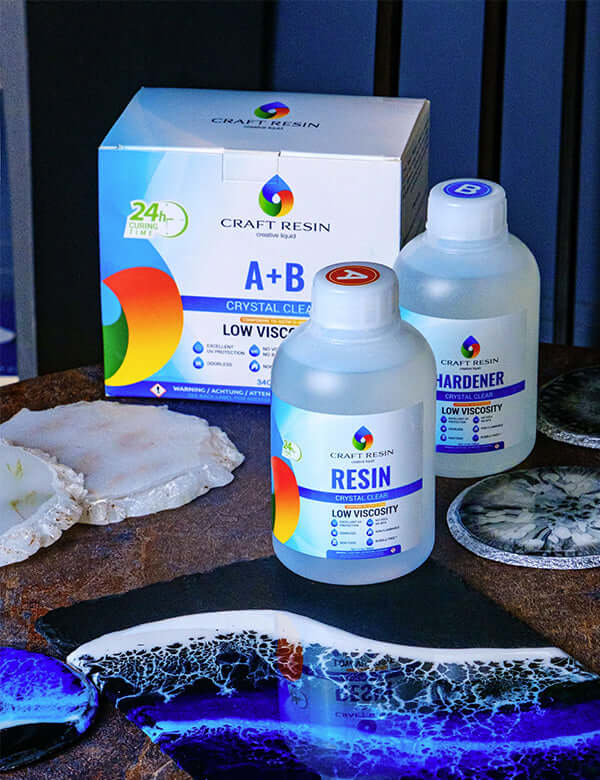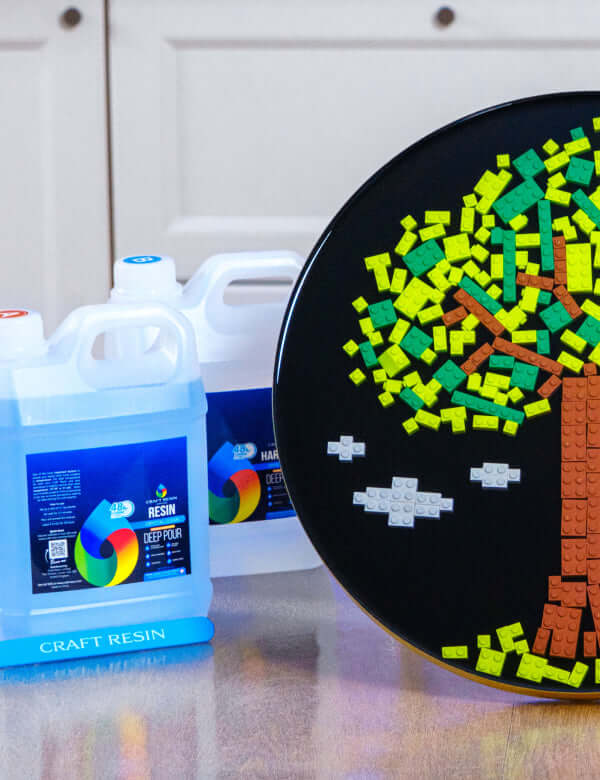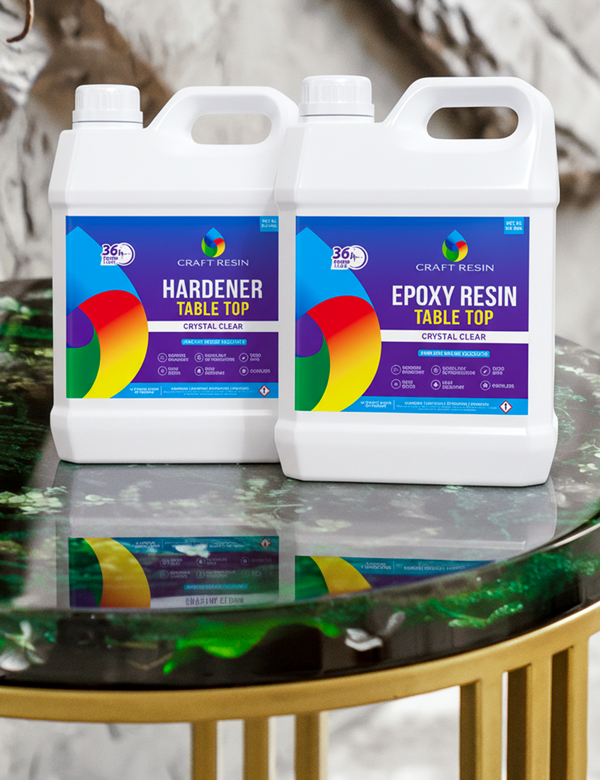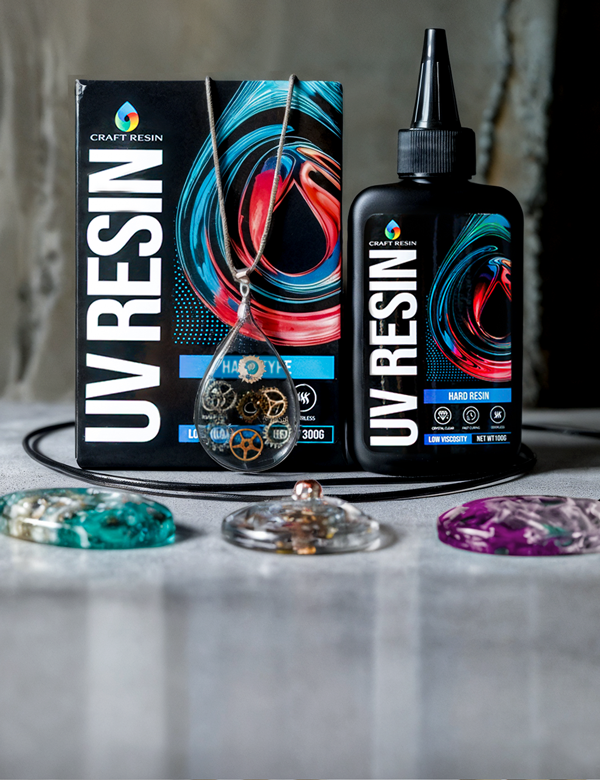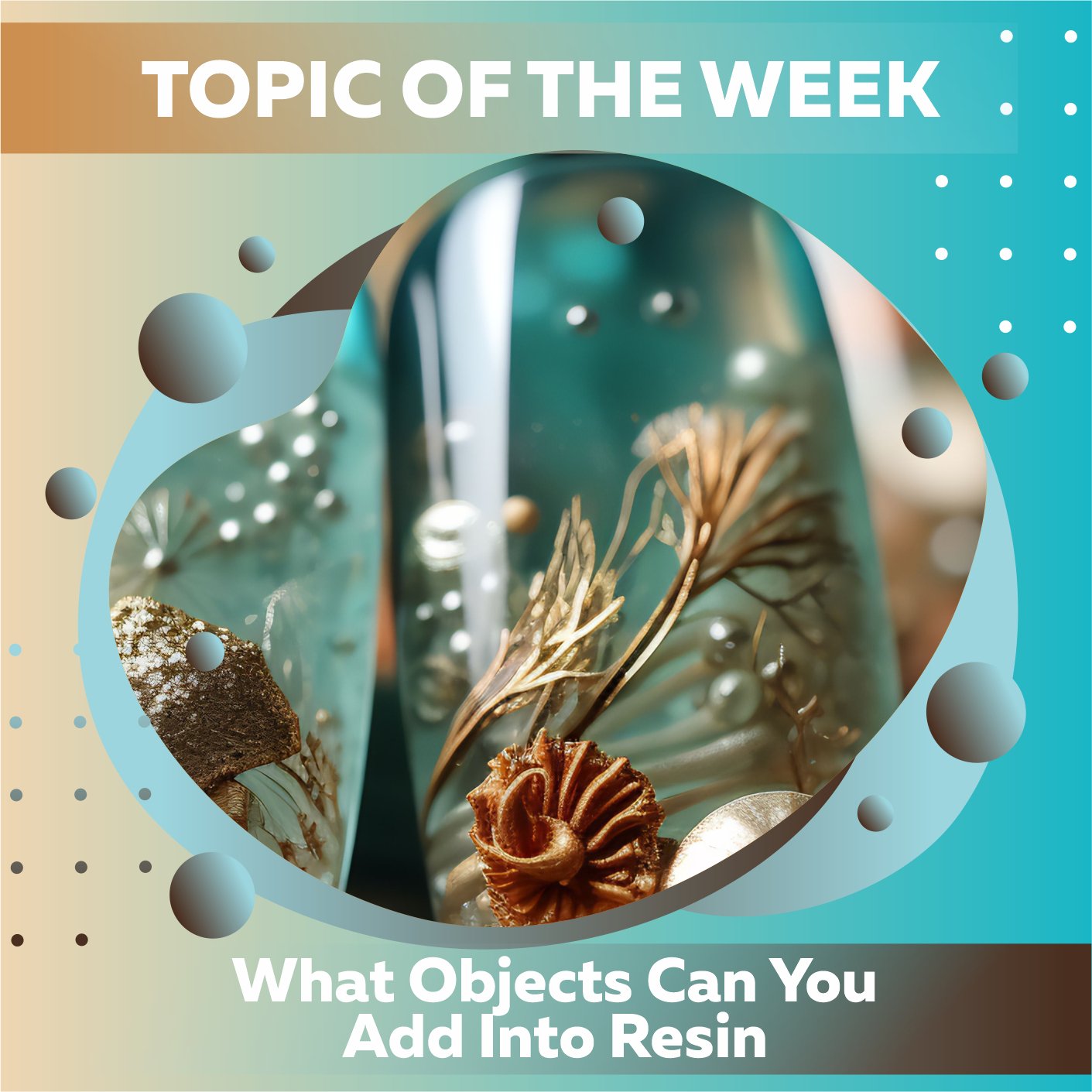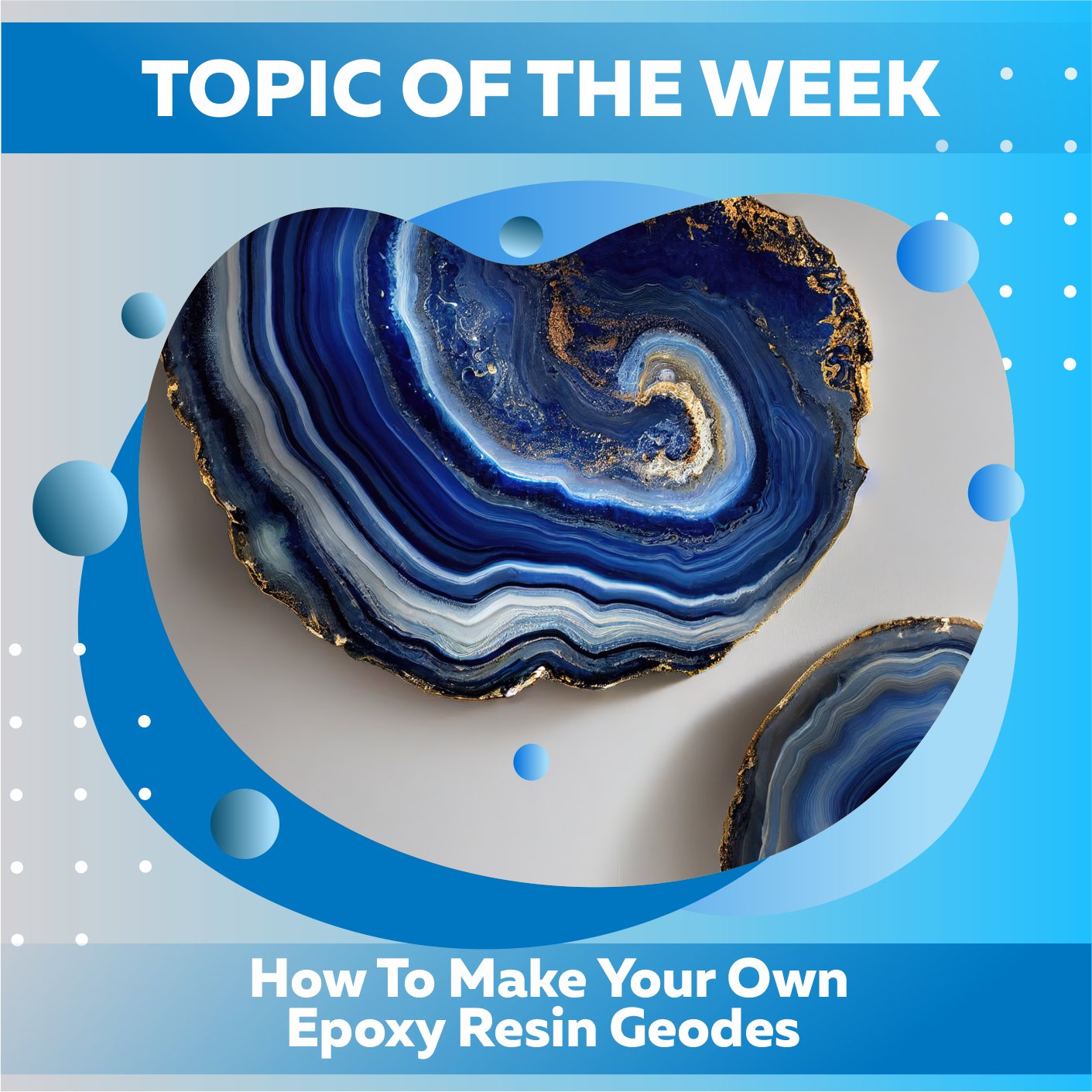Although we are asked weekly if something can be cast into epoxy resin, we decided to make a blog post to let you know some of the most commonly castable items.
The following is a list of some of the more common items that can be cast in epoxy resin, but, as with any creative project, there are always other items that may work. If you are still trying to decide, try several things independently. Caution should be exercised when casting sentimental items in resin; a comparable but less meaningful object should be used instead.

Objects That You Can Add Into Resin
Puzzle Pieces:
The epoxy glue that Craft Glue offers is simple to apply on top of a puzzle. However, before you do this, you will want to ensure it is firmly attached to a base, or the parts can get disorganized. To accomplish this, you will need to cut a piece of MDF board to the same dimensions as your puzzle, and then you will need to glue the puzzle to the board.
Again, the epoxy resin may seep into the puzzle and make it appear darker, especially around the edge of each puzzle piece. You could enjoy this appearance; it might work for your project or not. Therefore, we recommend applying a sealer to your puzzle first before applying the epoxy glue. Again, the epoxy resin dye may soak into the puzzle and make it appear darker.
You may need to apply more than one layer of epoxy resin to cover anything like a puzzle because the individual pieces have spaces between them. When air is allowed to escape between the pieces of the puzzle, it typically results in the formation of bubbles, which, when allowed to deflate during the curing process, results in pitting. Applying a second coat may fill in these pitted regions and make the surface more even. After the initial coat of resin you apply has hardened, you must remember to sand it down so that the subsequent layer will attach properly to the previous one.

Aluminum Objects:
Epoxy glue from Craft glue sticks effectively to various metals, including aluminum. However, before you apply the resin, you'll need to prepare the metal's surface by sanding away its top layer.
Jewelry:
Epoxy resin, which is available from Craft Resin, may be utilized in producing various jewelry items. Bangles, pendants, rings, and earrings are some of the most common types of jewelry that can be fabricated with Craft Resin. You may use molds or pour the resin into bezels to make them. The molds will hold the resin in place, and the bezels will give your jewelry pieces a beautiful edge.
Fabric:
Craft Resin won't completely absorb into the fabric, but it will still make it appear moist, and once it has fully set, it will cause the cloth to become stiff. It is recommended that you first try this wet look out on your chosen cloth to determine how the coloring and your project could be affected.

Polymer clay:
Epoxy resin from Craft Resin may be used on top of polymer clay. This may protect the sculpture from the elements, strengthen the structure, and give it a polished appearance. Epoxy resin applied with a paintbrush should be brushed over polymer clay sculptures again, this time being sure to get into all the sculpture's crevices. These may be dipped into a jug of Craft Resin, but only if your sculpture needs more.
Ceramics:
Ceramic tiles, such as Craft Resin supplies, may be permanently adhered to walls using epoxy resin. A smooth finish may be achieved by pouring epoxy resin directly onto ceramic tiles and placing them in position. When coating a bowl or a sculpture that isn't flat, one of the best options is to paint the resin onto the surface using a paintbrush and then build it up in layers.
Before utilizing ceramic plates coated with Craft Resin, it is important to give the resin adequate time to harden completely. On surfaces constructed from Craft Resin, the preparation of food is not only possible but also safe.
Warm ceramics before adding resin, as temperature shock is also a problem for ceramics. Before pouring, warm the containers briefly on a heat pad. When a heated resin mixture is put on a ceramic surface, the surface might contract, causing ripples or fissures in the finished product. This won't happen if you warm the ceramics beforehand.

Ashes:
In recent years, it has also been common practice to cast a loved one's ashes into epoxy resin so the owner can keep them forever. Ashes of loved ones and pets are also commonly scattered. Again, before you start, it's important to master the necessary skills and practice them on less meaningful work. Please test it out with something like sand first since it may have the same effect as ashes in resin.
Ashes are light, and because of this, they may move around quite a bit in epoxy resin while it is still liquid. If you pour epoxy resin on top of ashes, this can cause the ashes to become more dispersed, giving the appearance that there is less of a concentrated region of ashes. Please consider the following: the direction in which the ashes move may appear beautiful at times, but at other times, it may not, and this is something to keep in mind.
By preparing them first, You can ensure your ashes stay about only a little after you get started. You may put your ash into a little mold already shaped how you want it to be. After that, you can put a small quantity of resin into the mold, mix the ashes into the resin a little bit, and then let it cure for twenty-four hours. After that, you may include it in a bigger resin project to flawlessly encapsulate it while ensuring that it maintains its shape.
You will have a perfectly formed resin/ash heart piece to add to your larger crafts if you use a mold in the shape of a heart, which is fantastic if you want to use something like that.
Ash may also be used in a resin project during the mixing stage; once the resin and hardener have been combined for four minutes, the ashes can be added for the final minute of blending. You may next pour them into your mold, albeit, once more, there may be some movement; nonetheless, this may be the desired effect.
Ashes on their own may be rather dreary and much more boring when the resin is applied to them as if they were wet; sometimes, people add some glitter to them to make them appear more lovely.
It is important to have an in-depth conversation with customers about their ideal memorial project before beginning work on ash-based initiatives. It's preferable to prepare them in advance for the possibility that the final product will differ in appearance from their expectations due to the fluid nature of the resin. The ashes will be permanently stuck in the resin once it sets.
You'll find many results if you type "adding ashes to resin" into YouTube's search box. Learn from others' mistakes and then give or sell your finished memorial creations.
As you can see from the wonderful memorial project done below by one of our Facebook Community Group Members named Mandie Dite, ashes may be used to build something as beautiful and unique as the person or pet they honor. It's a touching memorial to a loved one in her family:

Hair:
There are a lot of individuals out there who have a strong passion for memorial projects that are produced with the hair of their cherished pets or who want to cast their infants' locks of hair from when they got their first haircut, etc. It has the potential to become an adorable personalized keepsake once more.
Since hair can move around in liquid resin mix once again, you will need to explore and see if you can use a little snip off of your own hair before attempting to sell any resin hair sculptures. In the same way that working with ashes may be a nostalgic experience, working with hair can also be. For this reason, you should first acquire more knowledge and then practice on hair that is less meaningful to you.
The problem you could run into while casting hair is that it might protrude from your project; thus, you should probably work in phases again. Cast it in a smaller mold in the shape you want, then add it to a bigger project. Alternatively, add it to a larger project in stages, trimming any pieces that stick out as you go.
If you are working on a project that others will see, remind them that hair may appear somewhat darker or as if it has a damp appearance to it. Adding colorant or glitter to a project with hair might be unnecessary because the hair itself can occasionally shine without adding any additional materials.
Again, many how-to videos on YouTube will walk you through the process of adding hair to epoxy resin projects before you get started. Look at Forget Me Not Memories by C below for ideas; she inserted a lock of hair between two hearts decorated with lovely forget-me-not flowers and a touch of gold leaf.

Flowers:
Epoxy resin projects can be enhanced by adding dried flowers, but remember that fresh flowers cannot be used. Your gorgeous fresh flowers may not appear as good after being preserved in epoxy resin for a few weeks. Please read our extensive instructions before beginning any flower-related epoxy resin crafts, especially those with an emotional or commemorative focus:
How To Add Flowers In Epoxy Resin Blog
How To Make Flower Coasters YouTube Video

Sand/Shells/Pebbles:
If you make lovely beach-themed sculptures from epoxy resin, you should incorporate beach-themed elements like sand, shells, and pebbles. When you add the epoxy waves to them, they may take on a beach scene appearance that is both stunningly accurate and incredibly beautiful.
When working with heavier components, such as shells and stones, remember that they will fall to the bottom of your sculptures if the resin mix is applied to them while the resin is still liquid. Before you add these weighted things, the initial layer of epoxy resin located below the shells needs to be allowed to dry for a little while so that it can stick out slightly and prevent the items from sinking to the bottom of the container.
There is more direction available to assist you in making resin crafts with a beach theme, and it is as follows:
How To Create Ocean Resin Art Blog
How To Create Ocean Waves Using Resin YouTube Video

Insects:
After the summer months, there is a trend of encasing insects and other small natural items, like butterflies, in epoxy resin to preserve them and display them for the long term.
Insects in resin tend to get a lot of positive feedback, but we also get many comments from individuals concerned that an animal was hurt to create the artwork. We expect most of you already know this, but we'd like to clarify. Please do not injure any animals or insects to include in your crafts, and if you must include them, make sure they are dead before encasing them in epoxy resin.
There are also high-quality replicas of animals and insects so that you might substitute a reproduction for the actual item in your artwork's encapsulation. In a resin pond, for instance, replica fish may look quite lifelike.
Wood:
In recent years, resin tables and chopping boards have become quite popular. Not only is it possible to overlay resin onto wooden items, but it is also possible to cast wooden objects into resin. Make sure you have a look at the advice on wood that is provided below because we have a lot of information on producing things out of wood and resin:
Working With Wood & Epoxy Resin Blog

Glitter:
Add glitter or other shiny materials if you want your work to stand out. Glitter may be added to epoxy resin to make the final product look more elegant and eye-catching. It's worth repeating that glitters may float in liquid epoxy resin and sink to the bottom of sculptures, so keep that in mind. If you want the greatest results, experiment with different glitters and glitter hues and observe how they form and move around in your creations as they cure.
Beads:
Beads may be a great addition to epoxy resin creations; our advice is to stock up on a wide variety of such things and experiment with them to find out what you like and how they behave in various projects. Be wary of them again settling at the base of your works.
Stickers:
You may also incorporate items like stickers into your designs. However, depending on the paper used for the stickers, it is recommended that the stickers be primed with a product like Mod Podge before the resin is applied to them. This will ensure that the stickers do not fall apart due to the resin getting on them. Priming will provide a protective layer, allowing you to pour resin over it without any concerns afterward.
If you think about stickers like you do images and follow the same kind of advice you would while casting photos, you should make sure everything is correct.

Plastic Trinkets:
Epoxy resin may be used to cast toys and other plastic things since it connects to other plastics (epoxy resin does not adhere to silicone, though). You could even build a diorama out of your child's favorite toy vehicles or action hero figurines from when they were little by casting them in epoxy resin and utilizing them in the construction of the diorama.
Even with their high level of popularity, epoxy resin pyramids might be improved by adding such components.
Cutoffs From Other Resin Projects:
Utilizing offcuts of cured epoxy resin in other projects that you make is a fantastic technique to reduce the amount of resin that is wasted. If you let all of your drips cure on a plastic table covering, and then once they have hardened, you break them up into bits, you may use these as wonderful embellishments to your new creations made with epoxy glue.
These are frequently referred to as Terrazzo Chips, and we like the work that @priscriptionresin has been doing utilizing terrazzo chips to create a variety of colorful, stunning creations. Click on the image below to be taken to her profile, where you can view more of her incredible work:

Crystals:
Crystals, which you would wish to incorporate into your stunning resin geode sculptures, are naturally quite expensive, as is geode art. Epoxy resin art starter kit may be used to create crystals, saving you money, especially at the outset.
Whether genuine or imitation, crystals may be added to epoxy resin with no problems. Many geode paintings have crystals left protruding from the surface to add a striking three-dimensional impression to the piece.
You can encapsulate crystals by covering them entirely with resin, although transparent crystals won't be as noticeable in your finished product as colored ones will.

Gold leaf:
Your resin works may take on another stunningly beautiful aspect if you sprinkle them with glitter miming gold leaf. Glitter can be sprinkled over finished crafts and secured with a final layer of resin paint or mixed into the epoxy resin itself just before it hardens. Both of these approaches are viable options.
However, if you search YouTube, you'll find many guides showing you exactly what to do. While mastering the art of gold leafing can be challenging and time-consuming, several instructional videos online help you get started.
Pills:
This is a bit strange, but the folks at @prescritionresin have been inspiring us lately thanks to their fantastic pill-based artwork. While you shouldn't waste any of your prescription drugs on resin art, you may add some interesting details to your sculptures by utilizing pills that have passed their expiration date and would otherwise be thrown away.
To be inspired by the works of @prescription_resin, click on the image below:

Coffee Beans:
Coffee beans are another everyday item that may be included in epoxy resin artwork. It makes sense, and if you're making coffee coasters, they go wonderfully with what you're doing them for since they tie in nicely with what you're producing them for.
There is no need to pre-treat the coffee beans because they may be blended directly into the resin or have the resin poured on top of them without any problems. Because they are heavier than the resin mixture, they will again sink to the bottom of the mold. If you want them to sit above the bottom of the mold, you should put them in after the resin mixture has begun to firm somewhat.

Food:
Now, why on earth would anyone waste food by putting it into epoxy glue? Let us assure you that we share your sentiment if that's what you're thinking. Lol. However, individuals like making various creations and experimenting with various materials.
We provided the fantastic artist @fuzzycomma with some of our resin for a particularly commissioned piece they worked on for Chicago Town Pizza. You can get an idea of what the project entailed by looking at the photograph that follows; as part of one of their holiday marketing efforts, the company was requested to cast pizzas in epoxy resin so that they could be hung on the Christmas Tree and a unique photo shoot was organized to document the event.
We spoke to Alison from Fuzzy Comma, who informed us that the pizzas were only good for a few days during the filming; she is still determining whether they are still good.
They are susceptible to rotting inside cured epoxy resin, much like anything else, such as natural things or food. Even though there have been instances of a hotdog and burger that have persisted for years after being cast in epoxy resin, the more processed food groups might survive the fresh ones (which doesn't make us want to have a hotdog or burger any time soon!).

Will materials Craft Resin NOT stick to?
As seen above, epoxy resin from Craft Resin may be used on a wide variety of materials. However, it is not recommended for use with the following (by no means an exhaustive) items:
- Disposable plastic paint sheeting
- Plastic sandwich/shopping bags
- Silicone molds, or anything silicone for that matter
- The non-sticky side of shiny tape
Artists may use these supplies to mix, pour, and clean up their resin without using single-use products, which can be a huge time saver. For instance, you can use silicone mixing jugs to mix resin, then left to cure in the jugs before being folded out, wiped clean, and used repeatedly.
In the comments section, feel free to discuss your findings (or failures) with Craft Resin's applicability to non-recommended objects/materials. There may be some extremely unusual stuff that we have overlooked, but that could serve as a source of innovation for others.
Topic Of The Week Giveaway:
We have attached a giveaway to this Topic Of The Week announcement on our Instagram platform; this is helping us to spread the knowledge of how to use epoxy resin further, but also enabling anyone who helps us to share this information to win free resin and mica powders.

To enter the weekly giveaway, please see the latest post pinned to the top of our Instagram feed and follow the instructions to enter:
Team Craft Resin

